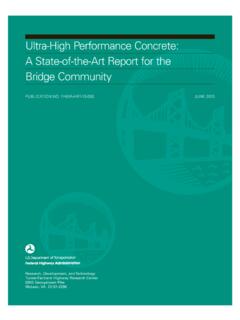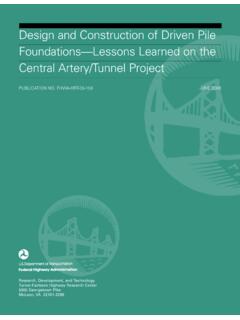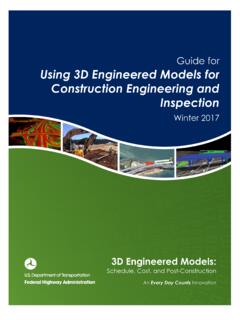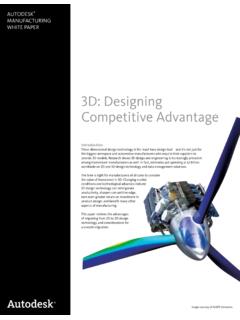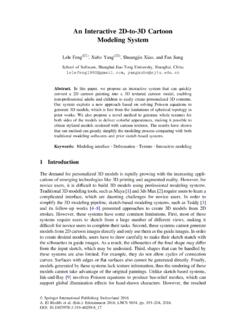Transcription of 3D, 4D, and 5D Engineered Models for Construction ...
1 TECHBRIEF3D, 4D, and 5D Engineered Models FOR CONSTRUCTIONEXECUTIVE SUMMARY MARCH 2013 ABSTRACTThis Technical Brief provides an overview of 3d modeling , including technology applications during design and Construction , benefits to stakeholders, resource requirements, current state-of-the practice, and advanced applications such as adding 4D and 5D Engineered Models (3D Models ) for Construction provide transportation agencies, contractors, and consultants a better understanding of the design with a virtual representation of project design. 3D Models allow for identification of potential conflicts and/or errors in design compared to traditional design and Construction techniques using 2D plans and profiles. 3D Models illustrate a project in a digital form that can then be analyzed to determine inconsistencies that would normally not be discovered until the Construction phase. The model can be tilted, rotated, and manipulated to provide various views of the designed roadway prism and features.
2 While there are design benefits to using 3D Models with visualization capabilities, perhaps a more significant benefit is that the data can be processed and used to automate Construction the last two decades, the vertical Construction industry has used 3D Models to improve the process for constructing buildings and other structures. This same process has been applied in several states to the horizontal (highway) Construction industry. But more work can be done to advance the state-of-the-practice in use of 3D Models . Agencies might begin with pilot projects or perform a full transition from 2D to 3D design shops. Often, contractors lead implementation by developing 3D Models post modeling allows stakeholders to visualize Construction over the project duration to identify potential spatial/temporal conflicts in schedule. Adding a cost component to the process creates a 5th dimension, making a 5D model . Such 5D Engineered Models allow stakeholders to evaluate costs and model cash flows for each phase of Construction .
3 Improved project delivery Improved communication Enhanced identification of errors Improved visualization Christopher Schneider, OVERVIEWLiDAR (Light Detection and Ranging) develops point clouds ( , a mass of data points generated to represent a three-dimensional project profile) that can be imported into 3d modeling software to help build a virtual representation of the finished Construction project. An initial survey establishes locations of physical features and key points as a baseline, and LiDAR technology is used to scan the area to produce data point clouds that ultimately represent the surface of a physical feature (examples include existing roadway segments, bridge columns, and existing drainage features). LiDAR technologies scan surfaces and generate point clouds that provide initial input data to the 3D model . Project specifications might require design-grade LiDAR, and freeway applications might use mobile LiDAR that can cover large areas in short time periods and generate detailed data sets for use in building the model .
4 Engineers then use this information as a basis for designing the facility which is added to the Models also have application during Construction , including earthwork computations, string-less paving of concrete, shop fabrication, automated machine guidance, and automated machine might deliver a 3D model directly to a contractor post-award or hire a consultant to develop a machine control file based on the 3D model that can be used to automate Construction activities and save on costs and time. Although not as common, the practice of providing a 3D model pre-award could create widespread project : LiDAR Point Cloud for Roadway Segment courtesy of ILDOT/MO State UniversityTop Right: CAD/Design Data courtesy of AutodeskTop Left: LiDAR Point Cloud courtesy of Autodesk23 BENEFITSSome key benefits realized from use of 3D Models include: Improved project delivery by accelerating Construction progress, making Construction more accurate and cost effective, and increasing safety on the job site.
5 Improved communication between key stakeholder communities ( , owner, public, consultants, contractor, utility companies, prefabricators, and material suppliers). Enhanced clash detection and identification of possible errors and inconsistencies in design before Construction . Improved visualization of subgrade features and potential utility owners: Random grade checks instead of at specified cross section distances. Material cost savings. Ease of finding locations for quality assurance contractors: Labor cost savings (reduced need for setting string lines for paving and stakes for grading), increased productivity, increased efficiency. Fewer conflicts and changes during consultants: Early identification of constructability issues, improved design accuracy, ease of visual verification for quality control. Once built, the model can be utilized throughout the full lifecycle of a facility and by various agencies, for example during infrastructure maintenance, operations, and asset management work.
6 66% savings for grade checking Up to 85% for reduction of stakes 3% to 6% by volume for improved material yields, and 30% to 50% for uninterrupted earthmoving results can equate to a savings of 4% to 6% of total project costs by using 3D Models . Contractors often claim 15% to 25% increased efficiency in earthmoving alone. One project had an 8-month schedule reduction and another project reported increases in productivity ranging from 40% to 50%.3D Interchange RenderingsBulldozer using a 3D model for DESCRIPTIONThe 3D Engineered Models are built using lines, points, and surfaces that depict a physical environment. Models use coordinate data that specifies horizontal and vertical point locations relative to a benchmark. These spatial relationships (where points on a surface are located relative to others) allow the model to be viewed from various angles while maintaining its overall shape and dimensions. The model s points can be located in the field using GPS.
7 This allows the graphical depiction to be translated into physical reality by precisely guiding equipment to construct the points, lines, and surfaces. 3D Models can help agencies with project reviews, design reviews, and environmental compliance. Models provided pre-bid in a performance specification will allow contractor innovation and reduce costs through application of data for machine guidance. The process also includes an initial control survey and LiDAR data collection to feed into the often claim 15% to 25% increased efficiency in earthmoving alone from the use 3D Fact:3D Models can be provided to contractors pre-bid. With the appropriate performance-based (versus method- based) specifications, providing 3D Models pre-bid could provide significant cost savings for the OF THE PRACTICEThe ultimate benefits of 3D Engineered Models extend beyond design and Construction to the full infrastructure life cycle, including maintenance, operations, asset management, and planning for future projects.
8 Once the 3D model is built, it can be used in perpetuity for managing roadway infrastructure and associated elements such as lighting, signage, drainage, and literature review of State DOTs JO 2012 BO JOUFSWJFX XJUI -BODF 1 BSWF 8J%05 QSPWJEFT TPNF TUBUJTUJDT PO DVSSFOU VTBHF PG % Engineered Models for DPOTUSVDUJPO CZ TUBUF BHFODJFT Some state-of-the-practice statistics are: State DOTs have varying levels of 3D model usage (some are advanced while some model the basic roadway prism). 23 state DOTs have transitioned to 3d modeling . 7 state DOTs are using only traditional 2D plans and profile sections. 15 state DOTs are transitioning to 3d modeling . Of the state DOTs using 3d modeling software 28 use Microstation- InRoads, 13 use Microstation Geopak, 2 use Civil 3D, and 7 use C3D + MS. Slightly more than half of state DOTs are using some type of LiDAR technology (aerial, static, or mobile).A b o v e : 3D Roadway Surface model courtesy of Iowa DOT7 GLOSSARY3D model A representation of a three-dimensional surface using specialized software that combines the height, width, and depth of the space model A 3D model intelligently linked with time or schedule related information for a model A 4D model intelligently linked with cost information for a Machine Guidance (AMG) Use of computers, positioning technology, and geospatial Models to provide horizontal and vertical guidance to operators of Construction Coordinates A location reference system that uses two perpendicular lines (for 2D) or the intersections of three mutually perpendicular planes (for 3D) as coordinate axes.
9 Cartesian systems do not recognize the curvature of the earth or the irregularities of the geoid. Civil Integrated Management (CIM) The collection of, organization of, and managed accessibility to accurate data and information related to a highway transportation facility. It is a total project approach that builds upon partnering and technology for designers, constructors, materials suppliers and maintenance personnel to design, build, and maintain a quality transportation project. Clash Detection Effective identification, inspection, and reporting of interferences between different elements in a 3D project Detection and Ranging (LiDAR) An optical remote sensing technology that can measure the distance to, or other properties of, a target by illuminating the target with pulses from a Cloud A set of points in a 3D coordinate system that typically represent the external surfaces of Engineered model VisualizationGrader using Automated Machine Guidance from 3D model DataAVAILABLE RESOURCESList of current documents and organizations with further insights into application of multidimensional Hill Smart Market Report The Business Value of BIM.
10 Of GPS Controlled Highway Construction Equipment (Vonderohe, University of Wisconsin) AASHTO AMG Quick Reference Guide ContactsBryan Cawley Christopher Schneider Richard McDaniel Engineered ModelDouglas Townes 8 FHWA-HIF-13-048



